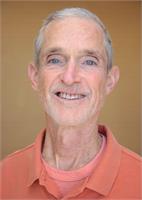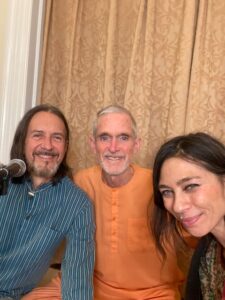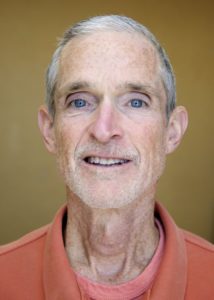Engaged Yoga — the Intersection of Yoga and Politics
by Jivana Heyman
In the aftermath of the violent insurrection at the U.S. Capitol, there has been a groundswell of voices from around the world joining together to denounce this violent movement by White Supremacists to overthrow the U.S. government –– except in yoga. Instead, in the yoga community, there seems to be some confusion about the relationship between yoga and politics. The argument I keep hearing is that yoga is not political, and that we should keep politics out of yoga spaces.
It’s pretty clear that this perspective comes from a place of privilege. Not everyone can choose to engage in a yoga practice that is divorced from the rest of their lives. As a gay man, I can tell you that everything in my life is political. Take for example my 28-year marriage to my husband, which was only legally recognized six years ago. I know that members of other marginalized communities would agree that our very existence is political. We can’t take politics out of our lives just for the convenience of our spiritual practice, or to make our practice more palatable to other people.
If you want to see the intersection of yoga and politics, you can look to India where prime minister Modi created International Day of Yoga to push his pro-Hindu, anti-Muslim agenda. Or, we can look a little further back in history to Gandhi, and the way he used the yoga teachings as the basis for nonviolent resistance. He led a movement that overthrew the colonial British government and inspired Martin Luther King Jr. and the Civil Rights Movement. The seeds are there, but unlike Engaged Buddhism, “Engaged Yoga” isn’t a thing. Instead, we spend our days arguing about whether yoga is political.
People who say yoga isn’t political usually base their arguments on one of two things: First, some say that yoga isn’t political because they believe the practice is mostly about fancy poses and physical attainment. I’ve spent the last twenty-five years trying to debunk that claim, and challenging the commercialization of yoga as whitewashed fitness. We know yoga offers us so much more. It can offer us nervous system regulation, peace, agency, empowerment, and of course, spiritual awakening. To me, this argument just shows a lack of understanding of the complexity of the practice.
The second argument is more insidious. It comes from a more traditional perspective, which states that yoga is not political because yoga is a completely internal practice that focuses solely on working with our own minds. This is a pretty good argument, because much of the history of yoga is about monastic ascetics who focused on transcending their limited bodies and minds to attain states of samadhi and escape rebirth. Yoga philosophy is full of teachings on this type of freedom from the limits of the natural world –– for monks.
Even today, you can find traditional practitioners in India who go to extreme lengths to overcome their body’s limitations. Yogis who hold their arms up in the air for years, or who never sit down. These ascetics, like most early yoga practitioners centuries ago, are consciously trying to separate themselves from society, which they do through an austere monastic life.
The problem with this argument is that the vast majority of contemporary yoga practitioners aren’t monks. We haven’t taken vows of celibacy, poverty, and nonattachment. We haven’t released all our worldly attachments to go live in a cave in the Himalayas. Instead, most of us –– if not all of us –– are just regular people living regular lives, having relationships with other people. Yes, we’re yoga practitioners, but we’re also parents, partners, business-owners, lawyers, construction workers, customer service representatives, grocery store clerks, reporters –– you name it.
If, like me, you’re living as a householder, that means you are engaging with society through relationships, through work, and through other aspects of an organized society. These social systems are guided by politics and the laws that firmly insert politics into our daily lives. If you’re a householder yoga practitioner, then your practice demands an additional level of social awareness. You don’t have to call it politics, but there is a way that your practice automatically becomes socially engaged because your life is. Practicing yoga is not an excuse to ignore what is happening around you. So, unless you’re a monk, you really have no excuse.
A perfect example of this is the misinterpretation of the teaching of nonattachment, vairagya, from theYoga Sutras of Patanjali. Most people think that nonattachment means becoming a monk, or getting rid of all their personal belongings. But nonattachment is a much bigger challenge than that. It is asking us to consider our essential selfishness, and to let go of the way our ego inserts itself into almost every interaction. Nonattachment is about transcending this basic self-interest and shifting to a place of compassion and connection –– which is a reflection of the truth of spiritual connection to all other beings. Unfortunately, this idea doesn’t sell well so we don’t hear much about it.
In contemporary yoga we still hear the echo of that monastic desire to leave society, and it sounds a lot like spiritual bypass. That’s the conscious, or unconscious, desire to avoid the painful parts of life. You have to admit, it is deeply ironic that we’ve taken the asceticism of our monastic past and mixed it with enough new age gobbledygook to transform it into a path that we expect to be lined only in love and light. A path so focused on our individuality that we have lost our humanity. So the question that we’re left with is this: How do we cultivate an engaged yoga practice that is both respectful to its ancient roots, and yet responsive to the reality of our sometimes confusing and often painful lives today?
Some of the people who stormed the Capitol on Janury 6th claim to be yoga practitioners –– I’ve heard of at least three teachers or studio owners who were there. Is that who we’ve become? Has yoga been so appropriated that a White Supremacist can practice without gaining any self-awareness? Sadly, this is just the next chapter in a long tale of yoga cults and indoctrination.
Why have yoga practitioners been such easy targets for brainwashing? I can’t help thinking that a denial of reality is at the basis of the problem. Yoga does ask us to reflect on the way that our own beliefs create our reality, but this doesn’t allow us to deny the shared reality that we are all experiencing –– even if it’s painful. The effort to distract or distance ourselves from the pain of others is not yoga. Instead, by working on our own attachments we can develop more compassion for ourselves and for others. Rather than allowing us to bypass painful feelings, the road to oneness actually leads us to a deep well of compassion. As Krishna explains in The Bhagavad Gita, “The yogi who perceives the essential oneness everywhere naturally feels the pleasure or pain of others as his or her own.” (Swami Satchidananda translation, 6.32)
What we’re seeing with Q-anon in the wellness world, and the recent violent uprising, is not a movement based out of love but out of selfishness. We’re seeing a group of people who are so privileged that they think they have been harmed in some way, that something has been taken away from them, when they are simply being asked to share equally with others. This is the epitome of White Supremacy and the kind of self-delusion that yoga is designed to strip away.
So let’s stop pretending that we are monks living in caves dedicating 100% of our lives to yoga. The reality is that most of us are householders who are making choices all the time regarding the way we spend our money, who we vote for, and how we talk to our friends about politics. As householder practitioners we have an extra burden of responsibility in our practice. That is the responsibility to apply the teachings in every aspect of our lives –– in our relationships, at work, and in politics.
This article was originally posted on the Accessible Yoga Blog.
 Jivana Heyman, C-IAYT, E-RYT500, is the founder and director of Accessible Yoga, an international non-profit organization dedicated to increasing access to the yoga teachings. Accessible Yoga offers Conferences, Community Conversations, a Blog, and an Ambassador program. He’s the creator of the Accessible Yoga Training, and the author of the book, Accessible Yoga: Poses and Practices for Every Body (Shambhala Publications, 2019). Jivana has specialized in teaching yoga to people with disabilities and out of this work, the Accessible Yoga organization was created to support education, training, and advocacy with the mission of shifting the public perception of yoga. More info at jivanaheyman.com
Jivana Heyman, C-IAYT, E-RYT500, is the founder and director of Accessible Yoga, an international non-profit organization dedicated to increasing access to the yoga teachings. Accessible Yoga offers Conferences, Community Conversations, a Blog, and an Ambassador program. He’s the creator of the Accessible Yoga Training, and the author of the book, Accessible Yoga: Poses and Practices for Every Body (Shambhala Publications, 2019). Jivana has specialized in teaching yoga to people with disabilities and out of this work, the Accessible Yoga organization was created to support education, training, and advocacy with the mission of shifting the public perception of yoga. More info at jivanaheyman.com






